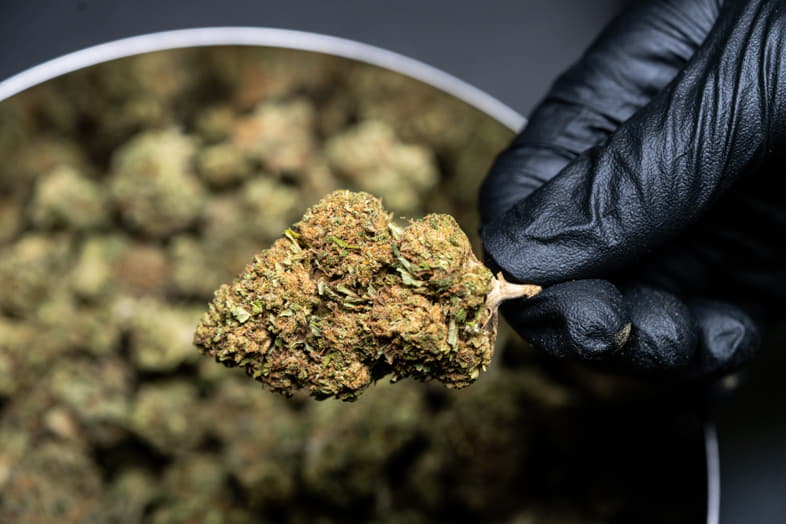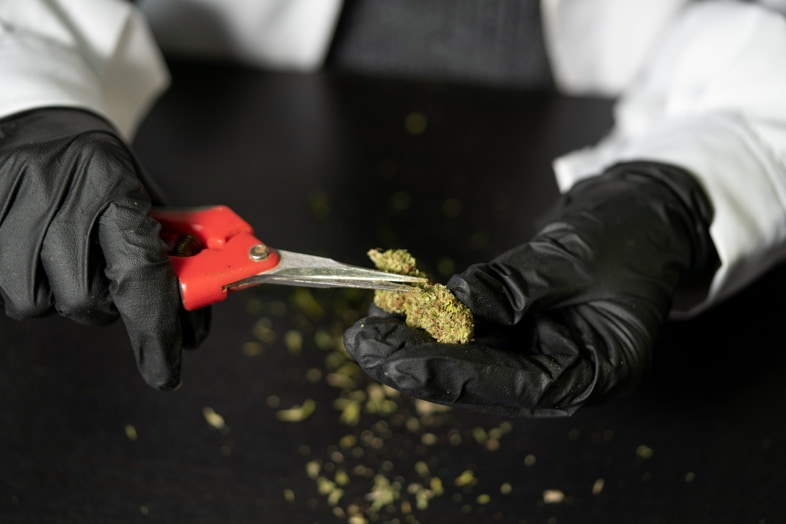Modified on: 20/09/2022
The process of trimming the inflorescences can enhance or detract from the quality of the finished product
Cultivating cannabis is a demanding job that requires weeks of patience. To obtain a quality end product, it is essential to pay proper attention to all the different steps, and one of these is trimming.
To do trimming with the proper technique, you need to be aware of the various methods available and make an informed choice as to which one is best suited to your needs. Did you know that you risk ending up with a bunch of mouldy flowers by not trimming your buds correctly? Or that you might experience a rather unpleasant smoke?
I do not doubt that you have no intention of messing up weeks of work by getting a procedure that is as important as it is simple. This article explains what trimming consists of and the best techniques to carry it out successfully.
Read also: Cannabis edibles: what they are and their effects on the human body
What is trimming and how is it done right?


For many experts in the field, it is also referred to as the cannabis manicure. After harvesting the buds, to achieve higher quality, it is essential to remove all the small resinous leaves attached to the flowers, and we will see why later.
On a practical level, this involves using a pair of reasonably sharp scissors and separating the premium product – the inflorescences – from the leaves, which will not be thrown away but will be used for other secondary preparations. But how is this so relevant? I will explain in the next paragraph.
Trimming: why is it important?
It might seem like a minor operation or even a purist exaggeration of a purely aesthetic nature, but in fact, it is not. Skipping the trimming phase or carrying it out without due precision dramatically reduces the quality of the inflorescences, even if they are of excellent quality.
Before proceeding to the tanning and drying stages, it is essential to prepare the buds and clean them of all those parts of the marijuana that are unsuitable for consumption. Removing the waste means purer buds, better for smoking and much less prone to mould and bacteria growth.
To trim your buds properly, you will need to arm yourself with the right tools, such as pruning shears and sharp scissors, and patience and attention. The issue of trimming is crucial for several reasons.
First of all, as I mentioned, the presence of small leaves in contact with the buds dramatically increases the risk of moisture being created during the drying phase, which, as you may know, is the number one enemy of cannabis.
Under these conditions, it is easy for mould and bacteria to develop and cause irreparable damage to the crop. Secondly, the leaves do not burn like the buds, and this will cause uneven combustion with negative consequences on the perception of the marijuana aroma.
Moreover, the leaves are pretty irritating to the lungs. Therefore, Trimming is essential to obtain velvety smokes with pleasant aromas and give the buds a neat and tidy appearance.
After all, you know, the eye wants its share too! Now that you understand how useful it is to trim your marijuana buds carefully let’s look at how it is done and which techniques are most popular.
Read also: What thrips are, why they are a danger to cannabis and what remedies to take to combat them
How is cannabis trimmed?


Both cases have advantages and disadvantages, and each grower chooses which one he prefers according to his needs. Let us now look in more detail at the main characteristics of these two techniques and how they differ.
Wet trimming
Wet trimming, or fresh trimming, consists of removing the excess part, such as twigs and small leaves attached to the buds, just after harvesting the inflorescences from the plant. This technique, therefore, must be performed before the drying process begins. Compared to dry trimming, which we will discuss later, wet trimming is much easier to do.
This is since it is easier to manoeuvre the still-flexible leaves, and they will also be easier to see before drying. Fresh trimming, therefore, is the method of choice, especially among beginners and those with less manual skill or patience. Even experts, however, tend to prefer it due to the faster process.
Moreover, this method is also adopted by large manufacturers who, using special trimming machines, consider wet trimming to be much more convenient in terms of time and practicality.
Dry trimming
On the other hand, Dry trimming involves trimming only after the branches cut from the plant have dried completely. However, as mentioned above, the various parts of cannabis will be much more challenging to locate and remove. As a result, you will get fewer clean buds and a less pure end product.
Why, then, would anyone prefer dry trimming over fresh trimming? If some growers prefer it, there is no doubt that they are consciously considering sacrificing one aspect in favour of another. But which one? A later trimming will give the cannabis a chance to retain much more resin than will be left attached to the wet trimmed buds.
Not dumb! In addition, the inflorescences dry more slowly when surrounded by more plant material, and this process gives the marijuana a much more intense aroma. A further aspect to consider is where to carry out the trimming. While wet trimming must necessarily be carried out outdoors, dry trimming also lends itself comfortably to indoor locations.
Dry trimming can be carried out in two separate steps to make work easier and faster. It is indeed possible and widespread to remove the larger leaves wet and then complete the trimming of the tops once they have dried thoroughly. This will allow more excellent protection of the trichomes due to the slower and more gradual drop in moisture content.
In conclusion, why is it essential to carry out trimming correctly?
Like all cannabis cultivation and processing stages, Trimming has its own rules and importance. Specifically, trimming results in a much more refined and pure end product. However, not properly removing the various waste parts that remain attached to the inflorescences means sacrificing the quality of the buds and the experience itself.
The sensation of smoking resinous leaves irritates the lungs and damages the aroma, which is less intense and pleasant. If the world of cannabis fascinates you, drop by our Sensoryseeds website.
You will find many products and interesting facts about marijuana. You’ll discover our wide range of quality weed seeds: feminized seeds, auto flower seeds, fast growing weed seeds, there is something for every taste!
Can’t wait to see you at Sensoryseeds.com!









